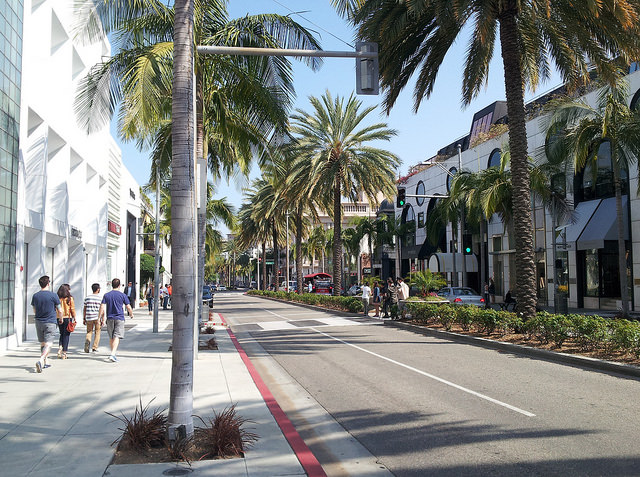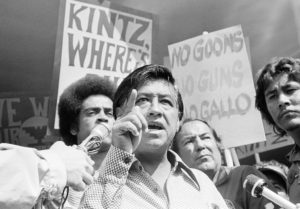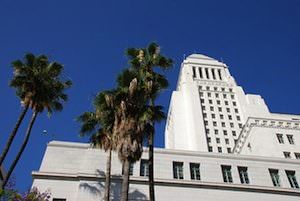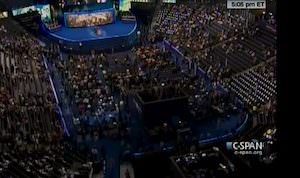The Ultimate Test of Trump’s Cronyism Is Unfolding in Beverly Hills
Los Angeles is eyeing a billion-dollar subway extension. An heiress' ties to the White House threatens to halt the project in its tracks. Daniel Davis / Flickr
Daniel Davis / Flickr
The Beverly Hills heiress waiting for Ivanka Trump at a Republican soiree last summer should have been at the height of her social powers.
Lisa Korbatov’s parents had made a fortune redeveloping Los Angeles’ Garment District and were donors for Republican and pro-Israel causes. Korbatov herself was president of the Beverly Hills school board and a trustee of the Jewish Community Foundation, and her local political activism had received swooning coverage from the staid Beverly Hills Courier, the hip LA Weekly and publications in between.
Three years ago, the local Boy Scouts even chose the blunt-speaking, charcoal-haired Korbatov for their 2015 Distinguished Citizen Award.
But Korbatov, 54, lately has become an object of derision in palm-shaded pockets of Beverly Hills. For eight years, she had led what passed for a heroic cause in auto-centric Southern California – fighting to derail L.A.’s nascent subway system. A planned 9-mile, $6.3 billion subway extension would tunnel under Korbatov’s alma mater, Beverly Hills High School.
Korbatov believes that the subway poses a dire threat to the school and the surrounding enclave of wealth and celebrity. And so, from her perch on the school board, she has done all she can to stop it.
She’s warned that students could be incinerated by exploding underground gases, poisoned or given cancer by seeping fumes, because the subway will run through the old oil fields that lie beneath much of West L.A. They might be targeted by terrorists attracted by the subway line. Perhaps the school itself will be demolished because of a subterranean construction accident while the tunnel is being built, she has claimed.
“You will not succeed, and we will stop you at every turn,” Korbatov warned subway boosters on the day in 2012 when the route was approved.
But LA Metro, as the region’s transit agency is called, has rolled through the turns successfully. The agency has debunked Korbatov’s theories about explosions and poisonous gas. It repeatedly has beaten the school district in court, obtained approvals and funding, and built a staging area near the high school for the coming big dig.
As her cause seemed increasingly hopeless, Korbatov became viewed as less of a noble crusader and more of a Chihuahua clamped to a pant leg. At her urging, the financially strapped school district has spent an estimated $16 million on lawsuits that failed. But even as Korbatov prepared to leave office at the end of 2018, her crusade continued in the form of a lobbying blitz, petition drive and more litigation.
For many in Beverly Hills – even those who never liked the idea of tunneling under the school – it’s time to stop fighting and try to negotiate a settlement with Metro that will pay to ease the disruption of the construction project.
But as Korbatov mingled among Republican donors at the private event in West L.A., she kept a dagger in her stocking: an affiliation with Donald Trump that she hopes to parlay into total victory in her anti-subway campaign.
For if the president can be persuaded to cut off federal funding for the subway project, the Purple Line will be stopped in its tracks.
So that’s what brought Korbatov to the soiree in June.
She donated $20,000 to a political action committee controlled by Bakersfield Rep. Kevin McCarthy in hopes of importuning the GOP House leader and his special guest, the president’s daughter, about the subway threat.
In case Ivanka Trump or McCarthy had questions, she brought the school superintendent with her. It was one more attempt to leverage her personal connection with Trump to the benefit of her anti-subway campaign.
***
The Republican woman from Beverly Hills surely seemed out of place on a stage with Hillary Clinton’s speechwriter, an Al Gore campaign adviser and a New York Times reporter.
It was January 2017, three days before Trump’s inauguration, and the University of Southern California was hosting a panel on presidential politics. Like everyone else in blue-state America, USC’s political scientists were trying to figure out what to expect. It turned out that Lisa Korbatov held in her pocket the new American political currency: a previous business encounter with Trump.
“I had a personal experience with him, as did my husband, through some business deal,” Korbatov said, in answer to a question about whether Trump would make peace with his critics once he took office.
“He couldn’t have been more calm and normal on the phone multiple times,” she said. “So I think some of this is a little bit of theatrics. I think he’s very practical, pragmatic.”
The business deal Korbatov referenced was a little-noticed, emblematically bizarre episode in Trump’s varied real estate career. In 2007, while Trump was in town to film “The Apprentice: Los Angeles,” Korbatov’s parents had bought a Rodeo Drive mansion from the family of the corrupt dictator of the African nation of Gabon for $10.5 million. The following year, they sold it, with Korbatov’s husband, a lawyer, handling the deal.
An investigation by Reveal from The Center for Investigative Reporting showed that Mokless Girgis, an Egyptian man with little money and a history of financial scams, paid $10.3 million cash for the property, according to real estate records.
Six weeks later, records show Girgis transferred the property – for no money at all – to a shell company set up for Trump by Michael Cohen, Trump’s longtime former fixer and lawyer.
In a filing, Girgis claimed his name had been put on the mansion deed by mistake and he never had owned the property. Korbatov’s husband, Igor, gave the same account, saying the wrong deed had been filed by the title company. Real estate experts who reviewed the transaction for Reveal said they found the story of the $10 million clerical error implausible.
Trump held the mansion for about a year, then sold it for $9.5 million – completing what, on paper at least, appears to be the best real estate deal he ever made. Girgis, pursued by creditors, later left the country.
Korbatov has other ties to Trump. The school district’s lead law firm in the subway fight – hired at Korbatov’s urging – is headed by Marc Kasowitz, a hard-edged New Yorker who for 20 years represented Trump in cases involving divorce, bankruptcy, sexual misconduct and Russian interference in the 2016 election. After Trump was elected, Korbatov began dropping Kasowitz’s name in an effort to draw the new president’s attention to the subway.
Korbatov also has a long association with Beverly Hills investment banker Elliott Broidy, a top Trump fundraiser. After the inauguration, Korbatov and Broidy wrote to Trump, urging him to stop the subway.
So far at least, those seemingly impeccable Trump connections have been of little help, largely because both men have been engulfed in scandals.
Kasowitz was forced to resign as Trump’s lawyer in 2017 amid reports that he might be ineligible for a White House security clearance because of a drinking problem.
Broidy became GOP persona non grata because news stories based on hacked emails portrayed him as engaged in a multimillion-dollar influence-trading scheme – even as he made hush-money payoffs to a Playboy model who was carrying his child.
And so, Korbatov began pressing House Majority Leader Kevin McCarthy and other pro-Trump lawmakers.
In June, at her urging, six GOP members of Congress – including California Rep. Devin Nunes, Trump’s champion on the House intelligence committee – wrote to Transportation Secretary Elaine Chao, urging her to cut off federal funds to the L.A. subway.
At an October gathering of school activists, Korbatov boasted that she had lobbied Trump herself and obtained a commitment from McCarthy to lobby the president on her behalf.
“I’ve gone to very high-level donor events as a donor, and I’ve talked to them and I pass on information and documents. I even saw the president. I gave him some letters and he accepted them a few weeks ago,” Korbatov said, according to an audio recording of the meeting obtained by Beverly Hills Weekly and shared with Reveal.
“I have been going to the large donors and getting letters, and the letters have been going to Kevin McCarthy. They pressure him because the only person Trump loves and listens to is Kevin McCarthy. So Kevin is the key. I saw him at least six times in a few months. He has told me that he will do it.”
Korbatov declined to be interviewed for this story. She referred written questions from Reveal to the school district’s lawyer, Terry Tao. In a letter, Tao reiterated the district’s concerns about “the danger and disruption” posed by the subway. He didn’t mention Trump. McCarthy’s press aide didn’t respond to requests for comment.
The wail of needy hangers-on is background noise to any politician’s life, growing louder the higher the political rung. Trump for decades has done business deals that have invited accusations of political back-scratching and other types of conflicts of interest. And since he’s been in office, stories about Trump friends getting what they wanted from the government have become something of a national and international news beat.
The subway saga points to Trumpian influence trading gone local.
The emerging Los Angeles mass transit system is the product of decades of ballot measures, public meetings, legal challenges and civic planning initiatives; even in Beverly Hills, voters overwhelmingly approved the system Korbatov fights.
Los Angeles, made famously sclerotic with traffic jams and endless sprawl, is in the process of redefining its core, with multi-story commercial and residential neighborhoods served by a growing spider’s web of transit lines. This in turn has attracted businesses whose workforce has no interest in sitting in gridlock.
Korbatov, however, is betting all that public process can be trumped – if only she can persuade the president to reach down into the federal transportation bureaucracy and cancel a grant that has long since been awarded to Metro.
***
When Denny Zane, the godfather of the effort to fund a grand expansion of L.A.’s transit system, says he will be in the car for quite a while with plenty of time to talk, it rolls off his tongue as though Angelenos say it to each other all the time.
In this motor raconteur spirit, the former mayor of Santa Monica recalls an evening in spring 2007 when he was driving along Olympic Boulevard in an attempt to get to an event in Beverly Hills.
“It was really stuck. It was going nowhere. And a blurb came on the radio saying, ‘LA Metro announced today that it has no money for any new projects for the next 30 years,’ ” he recalled. During the previous 40 minutes, Zane had driven 2 miles.
Meanwhile, the once-ratty wasteland of central L.A. was blossoming as technology companies erected regional headquarters in an expanding area boosters called Silicon Beach.
But car traffic, already horrible, was congealing to a point that it was making economic growth, and even workaday existence, unsustainable.
Zane knew then-L.A. Mayor Antonio Villaraigosa was a transit enthusiast. Zane told his left-wing pals that the mayor needed “a grand coalition” to get a subway built. Eventually, business and environmental groups got a measure on the ballot.
It seemed a long shot in the city built for the car. An early 20th-century system of trolleys had long ago been uprooted, and 1990s-era subway efforts had left the city with the 17-mile-long Red Line, a little-used, often-mocked service between downtown and North Hollywood. Los Angeles’ historic antipathy to public transit was epitomized in a 1991 academic book titled, “Transport of Delight.” It argued that L.A. mass transit supporters must have a psychological obsession with objects being inserted into dark tunnels.
But Los Angeles also has a history of rejecting orthodoxies – even its own.
And so in 2008, voters passed a half-cent sales tax increase to build what at the time was dubbed a “subway to the sea.”
City planners envisioned a new L.A. of high-density development combining restaurants, arenas, hotels, apartments and theaters, all within steps of each other. To make the whole thing work better, hundreds of miles of transit capillaries would emanate from new subways. One, called the Purple Line, would transect Beverly Hills along a route yet to be determined.
***
Lisa Korbatov had been elected to the school board in 2009. She became the board’s dominant personality, with opposition to the subway her signature issue.
At first, Metro had plotted a route for the Purple Line beneath busy Santa Monica Boulevard to a station among the high-rises of Century City. But earthquake experts warned that the Santa Monica fault posed a threat.
To reduce earthquake danger, Metro in 2011 proposed moving the station several hundred feet to a site just a few blocks from Beverly Hills High. The change required putting the subway line in a tunnel beneath the school. Despite a howl of protest from Beverly Hills residents, officials approved the new route at a stormy meeting in 2012.
To some, the plan desecrated a 91-year-old Southern California landmark known for its movie star alumni, dormant oil wells and the “Swim Gym” – a basketball court that converts into an indoor pool.
To Korbatov and her allies, moving the subway a few blocks was a catastrophe.
***
On a blue-sky Southern California day, fresh-faced students in shorts and backpacks trudge among manicured hedges toward a cluster of French Normandy-style classroom buildings. Suddenly, an orange fireball obliterates the scene.
“Methane gas, toxic chemicals and teenagers don’t mix,” intones a bass-baritone narrator’s voice. “But this dangerous combination is on the verge of exploding at Beverly High, turning the school into a mega-disaster.”
The spliced-in explosion was the centerpiece of a 2012 video deployed by the school district in its anti-subway lobbying campaign. The project would bring explosions, health hazards, cave-ins – at least according to the video.
Two years later, YouTube videos created by Beverly Hills students repeated the litany of dangers.
“Are we being hysterical?” asked a school board member in one video. “No!”
Even worse might be in store, Korbatov has claimed. In 2010, she told Beverly Hills Patch, that “our high school, with its reputation as having affluent and Jewish students, would make a good target” for terrorists attracted by the subway.
Korbatov also accused subway boosters of political corruption.
Then-Mayor Antonio Villaraigosa and longtime County Supervisor Zev Yaroslavsky had pushed the subway to “take care of a couple of developer friends who bundle and give large political donations,” she claimed in a news release.
Both Villaraigosa and Yaroslavsky have been out of office for years, but Korbatov continues to complain that the subway project is corrupt.
“This is Metro – this is what they do to communities,” she declared during a school board meeting in June. “They lie. They lie and they use your taxpayer dollars to just run roughshod over your liberties, your sanctity and your sovereignty.”
***
In 2012, shortly after the route was approved, the school district filed lawsuits in state and federal court claiming the project violated environmental laws.
Environmental studies ignored earthquake dangers, underplayed the risk of toxics and explosions, and failed to note the subway might make the high school unusable, the lawsuits claimed.
For its part, Metro contended that the subway would be perfectly safe and posed no threat to anybody, and it argued that its $13.8 million in environmental studies had been done by the book.
The following year, Lisa Korbatov pushed the school board to hire Marc Kasowitz’s law firm to take over the case. She wanted the help of the firm’s top lobbyist: Joe Lieberman, the former Connecticut senator and Democratic vice presidential nominee. Lieberman had political ties to West Coast Democrats. Perhaps he could persuade the mayor to reroute the subway.
But negotiations went nowhere, and Beverly Hills never got any traction in court. In 2014, a judge tossed the school district’s state lawsuit. An appeal fell flat. The federal courts took longer, but in 2017, the district’s federal lawsuit also was rejected. The district responded by filing yet another lawsuit.
The litigation is pricey, and the district really cannot afford it. Beset by declining enrollment and high costs, Beverly Hills schools have been running a deficit, the county Office of Education says.
To pay the lawyers, the school board has spent the proceeds of voter-approved school construction bonds. The district contends that’s legal. But the district’s own auditors have red-flagged the issue, noting that the state constitution requires that school construction bonds be “used for specific school facilities projects only.”
Nor is the district forthcoming about what the lawsuits have cost. Franklin Tell, a lawyer who serves on a citizens committee set up to oversee bond spending, estimates legal fees have topped $16 million. Nobody knows for sure, he said.
The district refused to let the committee see the lawyers’ invoices, saying the bills were confidential, records show. Tell worries that the latest lawsuit will run legal bills even higher on what he is convinced is a lost cause.
“The hubris, arrogance, and ego driven stupidity to commence yet another lawsuit after its appeal was denied, confirms my worst fears that this fiasco has gotten completely out of control,” he wrote in an email to the school board in May.
***
Trump’s election seemed to open a new path for derailing the subway: The Kasowitz firm had serious juice with the new president. Partner David Friedman, who had been Trump’s bankruptcy lawyer, became U.S. ambassador to Israel. Joe Lieberman was mentioned as a candidate to succeed fired FBI Director James Comey. Marc Kasowitz himself took on the high-profile job of leading the legal team representing Trump on the special counsel’s Russia probe.
In Beverly Hills, Lisa Korbatov boasted that Kasowitz played golf with the president, a person who knows her says.
In March 2017, Korbatov wrote to Trump, calling the subway a “financial fiasco” and again mentioning explosions. The letter made a point of noting that the school district was represented by Kasowitz.
But the meeting she requested never materialized, and soon Kasowitz was no longer Trump’s lawyer. In July 2017, ProPublica reported that Kasowitz “had struggled intermittently with alcohol abuse” and had not sought a security clearance, perhaps fearing he was ineligible. When a critic sent an email to Kasowitz urging him to resign, the president’s lawyer went off, writing: “Watch your back, bitch. … Don’t be afraid, you piece of shit. Stand up.”
After ProPublica published the exchange, Kasowitz resigned as Trump’s lawyer.
So Korbatov turned to another Trump connection: Elliott Broidy, a wealthy investment banker and an old family friend from L.A. Jewish and Republican circles.
Like her parents, Broidy for years had given generously to pro-Israel causes, and he was also a major GOP fundraiser, serving as finance chairman of the national Republican Party under President George W. Bush. In 2008, when Bush took a delegation of prominent American Jews to Israel, delegates included Broidy and Korbatov’s mother, Selma Fisch.
In 2009, Broidy’s career nearly had been wrecked when he was implicated in a pay-to-play scandal at the New York state pension fund. But he rebuilt his investment banking business and became a heavyweight Trump fundraiser, serving as vice chairman of the Trump Victory Committee PAC and vice chairman of the president’s inaugural committee.
When Korbatov wrote to Trump about the subway, Broidy also signed the letter. Broidy, it seemed, would be her new ticket into Trump’s orbit.
In 2018, a promising opportunity to use Broidy’s ties to the president arose: Broidy was co-hosting a $35,000-per-plate fundraiser for Trump in Beverly Hills.
But Broidy, too, fell from grace after hacked emails implicated him in an influence-trading scandal that involved hundreds of millions of dollars in contracts with the United Arab Emirates, Malaysia and other countries seeking access to Trump. A $1.6 million hush payment to former Playboy model Shera Bechard, set up by Trump’s fixer Michael Cohen, cemented Broidy’s status as a pariah.
Broidy was dropped from the fundraiser. He resigned as deputy finance chairman of the Republican National Committee, and Korbatov had lost another entrée to Trump.
In the spring, Korbatov began cultivating Indiana Rep. Todd Rokita, a hardline Trump supporter on the House Transportation and Infrastructure Committee.
At the time, Rokita was running in a U.S. Senate primary, telling voters, “I’m pro-life, pro-gun and pro-Trump.” Korbatov donated $3,400.
After he lost, Rokita went back to Congress and began circulating a letter to Transportation Secretary Elaine Chao warning of the subway’s threat to Beverly Hills High: Students might face “coughing, dizziness, nausea, and headaches” or even “cancer, chronic asthma, and other respiratory illnesses,” he wrote. Rep. Devin Nunes and four other California GOP lawmakers signed Rokita’s letter, which sought a meeting to discuss the $1.2 billion in federal funds granted to LA Metro to extend the Purple Line.
But like the other approaches, no immediate action resulted.
***
Meanwhile, Metro set up a staging area next to the high school to begin work.
The move energized opponents. More than 5,300 people signed an online “Stop the Purple Threat” petition addressed to Trump. In October, Superintendent Michael Bregy helped organize a districtwide student walkout to protest the subway, with a noisy rally at a park near a property Trump owns. But the effort produced no discernible headway, and the Los Angeles Times editorialized, “Seriously, Beverly Hills? Cut your Purple Line hysteria, already.”
For many in Beverly Hills, it was long past time to abandon the fight.
The district’s losing battle “continues to waste millions of dollars that are earmarked for school improvements,” said former Mayor Stephen Webb. The project “is not going to be dangerous to the kids,” he said. “I wouldn’t have supported it if it were.”
“Fighting Metro is a lost cause,” said former school board member Herbert Young.
But Lisa Korbatov seemed determined to continue fighting the subway even after her term on the school board expired at the end of the year.
As she recounted in a series of WhatsApp messages to subway opponents, she was buoyed by an encounter with the president, apparently at an event at the Trump hotel in Washington.
On Oct. 5, she wrote that she recently had spoken to the president and had given him important documents about the subway issue.
“He knows,” she wrote. “He told me he’s (going to) look into it.”
Trump’s daughter also seemed receptive, she wrote. “Ivanka got two packages from me. One I gave her two months ago and spoke to her. … She knew me, and knew the issue.”
In the meantime, she urged subway opponents to “bombard the White House” with emails and calls, declaring, “They all cave in to pressure in DC.” She also urged opponents not to lose heart.
“You all need to trust me,” she wrote. “Nobody knows more than me.”
This story was edited by Andrew Donohue and copy edited by Nikki Frick.
Your support matters…Independent journalism is under threat and overshadowed by heavily funded mainstream media.
You can help level the playing field. Become a member.
Your tax-deductible contribution keeps us digging beneath the headlines to give you thought-provoking, investigative reporting and analysis that unearths what's really happening- without compromise.
Give today to support our courageous, independent journalists.



You need to be a supporter to comment.
There are currently no responses to this article.
Be the first to respond.